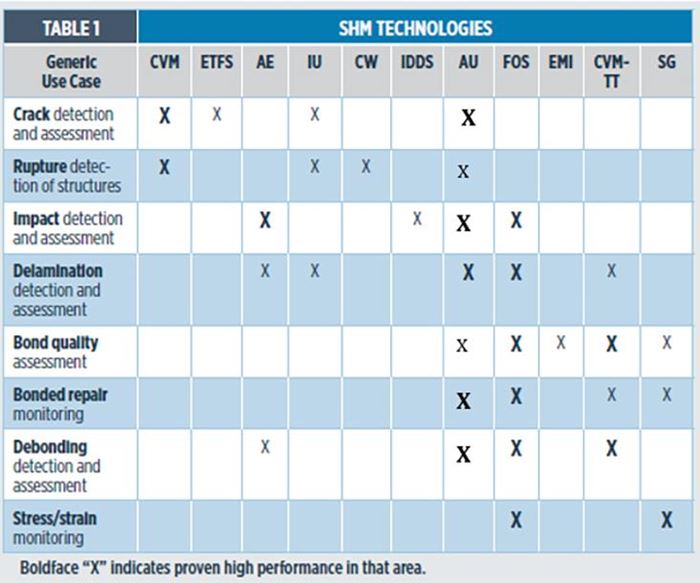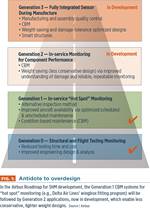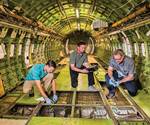Structural health monitoring: The toolbox
There are a broad range of SHM technologies that take advantage of a variety of sensing mechanisms. Here's a short sketch of each, accompanied by tables that indicate current uses and developmental progress.
Although CW’s coverage of structural health monitoring (SHM) technologies in this issue focuses on those most actively employed in testing/demonstration environments and most ready for widespread deployment, there are a broad range of SHM types that take advantage of a variety of sensing mechanisms. The following is a short sketch of each, accompanied by two tables that indicate current uses and developmental progress.
Acoustic Emission (AE): Passive transducers listen for matrix cracking, delamination and fiber breakage.
Acousto-ultrasonics (AU): A grid of piezoelectric sensors sends and receives ultrasonic pulses and analyzes changes in wave patterns to identify and describe damage.
Comparative Vacuum Monitoring (CVM): The smallest air flow can be detected when galleries alternating between atmospheric pressure and vacuum (enabled by Teflon manifold patch) are breached by a crack or resin microcracks.
CVM Through the Thickness (CVM-TT): A <1 mm-diameter hole drilled through a composite into adhesive uses the CVM principle to detect disbond and delamination.
Crack Wire (CW): Conductive/resistance wires that trigger alarms when severed by cracks or damage.
Electro-Magnetic Interference (EMI): Uses embedded piezoelectric sensors and impedance analyzer. Increasing levels of internal release agent and moisture contamination, for example, produce increasing deviation from a reference index, indicating weak bonds.
Eddy Current Foil Testing Sensors (ETFS): Sensors generate an eddy-current field in conductive metals, which is disrupted by cracks and corrosion.
Fiber Bragg Grating (FBG): A mature type of Fiber Optic Sensing (FOS), it uses alterations in the refractive index of an optical fiber to measure temperature, strain and vibration as well as acoustic and ultrasonic signals for crack and damage monitoring.
Impact Damage Detection System (IDDS): Developed by Kawasaki Heavy Industries, this system uses two combined methods: (1) optical intensity measurement before and after impact, using optical fibers to assess damage and (2) shock wave measurement for impact localization via FBG sensors.
Imaging Ultrasonics (IU) — Miniaturized, integrated sensor networks generate a signal through the material. Changes in wave reflection indicate flaws or damage.
Strain Gauges (SG) — These output strain, stress and load, using traditional electrical foil sensors and an input voltage. Newer sensor types include fiber-optics, microelectromechanical systems (MEMS) and printed conductive-ink sensors.
This short article is a sidebar to a feature story titled "Structural health monitoring: NDT-integrated aerostructures enter service," for which there is also a companion sidebar, titled "Structural health monitoring: Decades of demonstrations build confidence in local SHM." To read either story, click on its title under "Editor's Picks," at top right.
Related Content
-
PEEK vs. PEKK vs. PAEK and continuous compression molding
Suppliers of thermoplastics and carbon fiber chime in regarding PEEK vs. PEKK, and now PAEK, as well as in-situ consolidation — the supply chain for thermoplastic tape composites continues to evolve.
-
Materials & Processes: Fibers for composites
The structural properties of composite materials are derived primarily from the fiber reinforcement. Fiber types, their manufacture, their uses and the end-market applications in which they find most use are described.
-
Materials & Processes: Resin matrices for composites
The matrix binds the fiber reinforcement, gives the composite component its shape and determines its surface quality. A composite matrix may be a polymer, ceramic, metal or carbon. Here’s a guide to selection.
















.jpg;maxWidth=300;quality=90)
